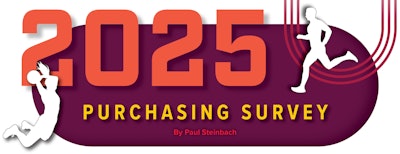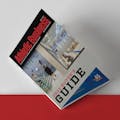
Recent iterations of the annual Athletic Business Purchasing Survey have suggested a steady return to normalcy since the — we hesitate to even repeat the words at this point — COVID-19 pandemic. This year’s record number of responses were gathered in the weeks surrounding Inauguration Day in the United States. Did the results of a closely contested presidential election impact how leaders in the athletics, fitness and recreation industries view their own financial decision-making processes and economic prospects moving forward? You decide.
First, let’s look at this year’s survey respondents — 42.1% of whom represent athletic departments, 33.2% recreation departments and 15.2% fitness operations. A clear majority clock in on either college (34.5%) or high school (23.5%) campuses. Meanwhile, 14% represent the private sector, 13.1% municipal or public agencies, 10.4% non-profit organizations and 1.2% military installations. More than half of this year’s sample oversee facilities that accommodate between 201 and 5,000 users, with the breakdown as follows: 19% at 1,001 to 5,000; 16.8% at 501 to 1,000; and 15.2% at 201 to 500. An additional 40% of the sample host more than 5,000 users, with the following breakdown: 11.9% at 5,001 to 10,000; 9.8% at 10,001 to 20,000; 9.5% at 20,001 to 50,000; and 8.8% at more than 50,000.
More than twice as many respondents report their 2025 budgets increased rather than decreased when compared to their 2024 budgets — 30.5% “increased” to 13.4% “decreased” — while most of the survey (56.1%) indicated no change. That “increased” percentage falls right between last year’s 30% and the record-tying 31% reported as recently as 2023. The “decreased” figure represents a significant uptick from 2024’s all-time low of 9%.
Our sample ranks facility improvements (38.4%), sports equipment (19.8%) and fitness equipment (16.2%) as the three categories that consumed the most budget dollars last year, and those same categories represent respondents’ top anticipated investment priorities for 2025, as well — 47.3%, 17.1% and 11%, respectively. Sports surfaces land as the number four priority in 2025 after ranking sixth on the list of actual 2024 expenditures in this year’s survey.
A full 57% of our sample report a facility project in progress (9.1%), set to begin this year (19.2%) or planned within five years (28.7%), but that’s a 5-point dip compared to last year and 4 percentage points below our yearly average. Nearly three-quarters (74.3%) of these projects will cost less than $10 million, while 21.2% fall within the $11 million to $50 million range, and 4.5% will exceed $50 million.
We again asked respondents how much they agree with the statement, “Our current budget and operations have returned to pre-pandemic norms.” A four-year high of 21% responded, “Strongly agree,” while 20.4% responded, “Don’t agree at all” — a new low.
When asked if they are worried about the macroeconomic climate in 2025 and whether it will impact their purchasing decisions, 48.2% of respondents said they are not worried and thus not altering their plans. That’s up from 42% last year and 35% in 2023, the first year we posed the question. Another 51.8% of the 2025 sample said they are worried, but only 24.4% said that worry would translate to altered purchasing decisions — reflecting a steady three-year decrease from a high of 34%.
Nearly 28% of respondents report having made changes to purchasing plans within the past year, while the vast majority (72.3%) made none, marking the largest disparity between those figures since “no changes” votes overtook “changes” votes post-pandemic.
Moreover, this year’s sample seems generally optimistic about the future. A full 22% of respondents are “Convinced we’re heading into a period of growth and prosperity,” while twice as many (47.6%) hold the more tempered view that the “potential” exists “for better days ahead,” and half as many (11%) are “Concerned our best days may be behind us.” The rest of our respondents (19.5%) remain unsure.
On some level, none of us can be completely sure what twists and turns the road ahead might present, but our hope is that the annual AB Purchasing Survey at least maps out a few industry trends to help you navigate your chosen course. With our ninth survey sample being our largest to date, we — as always — wish to thank all participants for sharing your input, and we look forward to hearing from you in 2026.








































